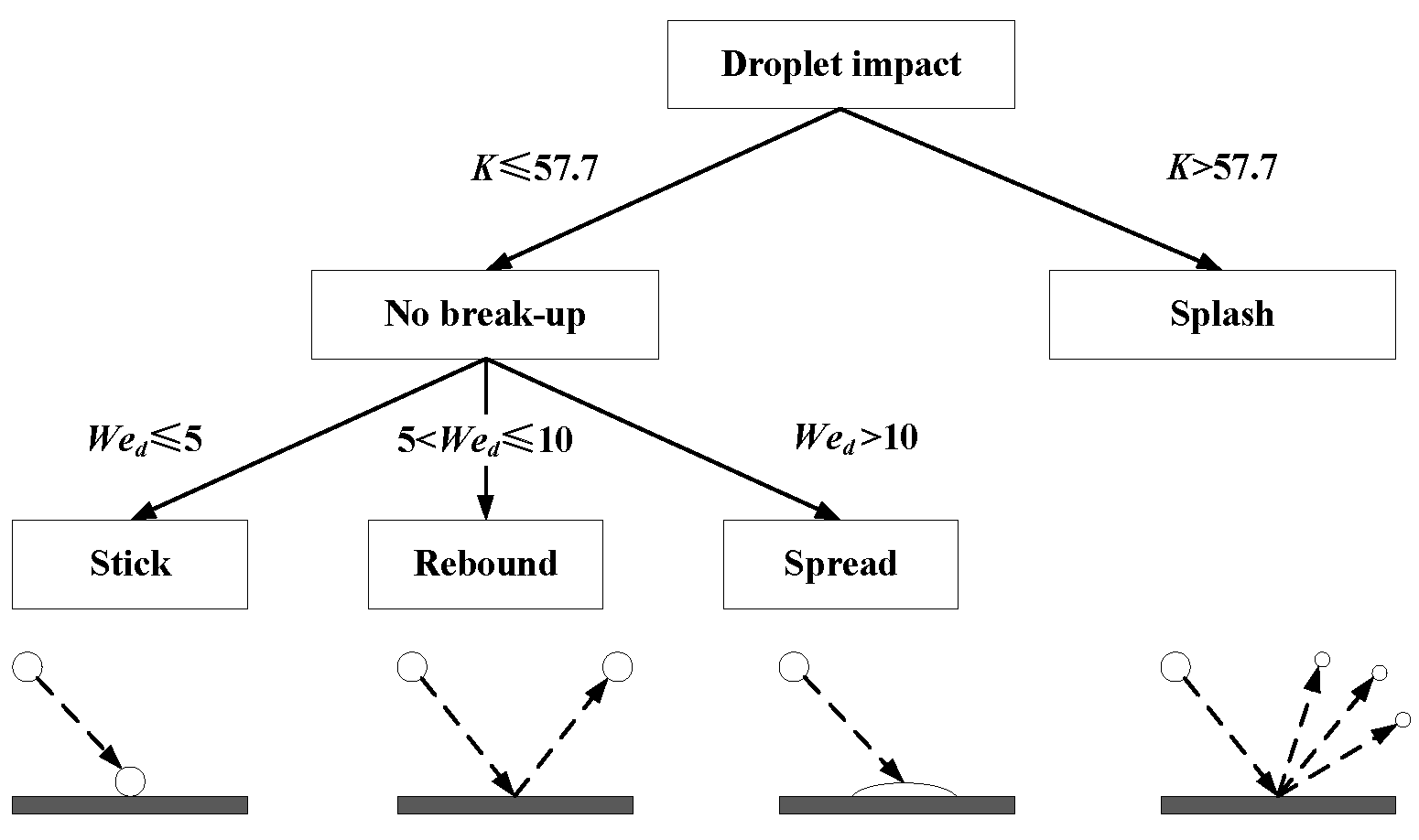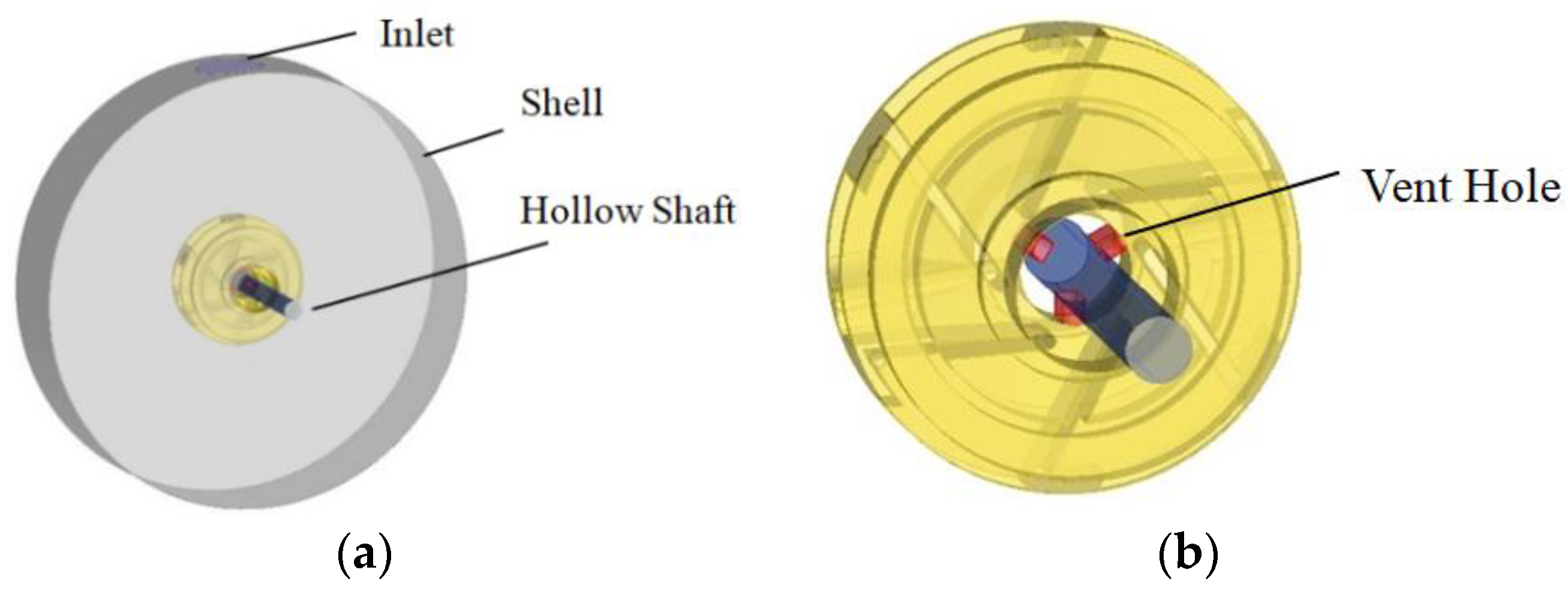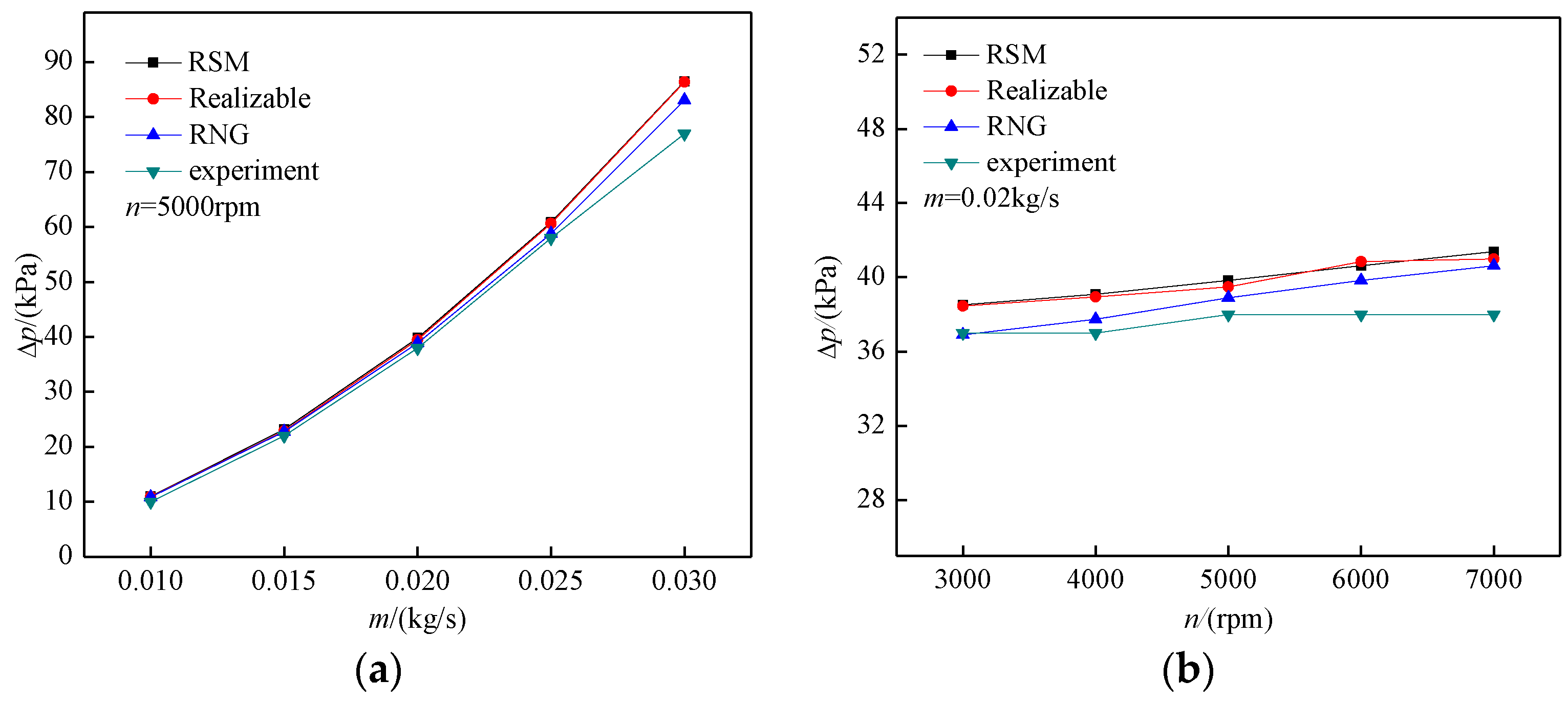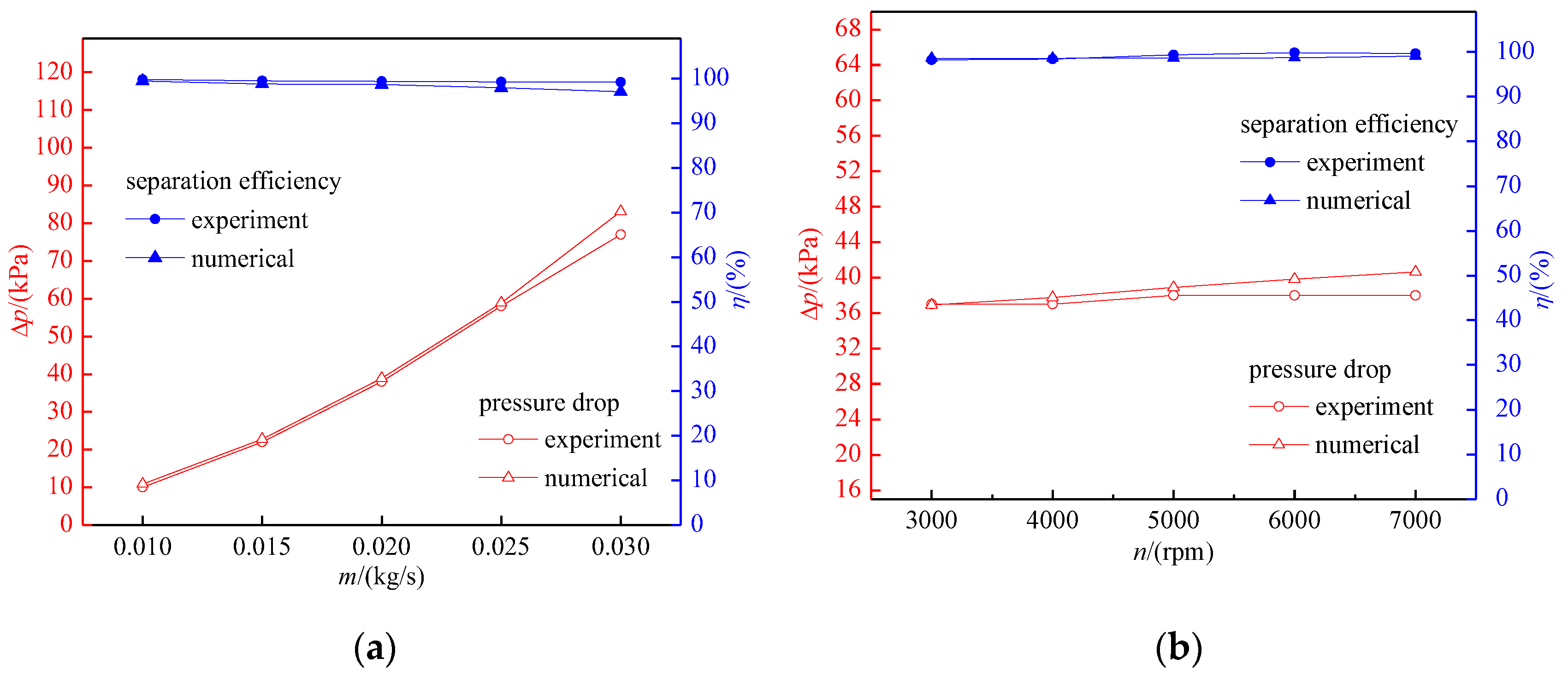Research on Performance Prediction Model of Impeller-Type Breather
Abstract
:Featured Application
Abstract
1. Introduction
2. Numerical Method
2.1. Two-Phase Flow Calculation Method
2.1.1. Governing Equations for Gas Phase
2.1.2. Oil Droplet Motion Equation
2.2. Wall Liquid Film Model
3. Model Building and Model Validation
3.1. Physical Model
3.2. Grid Generation
3.3. Model Validation
3.3.1. Single-Phase Model
3.3.2. Two-Phase Model
4. Data Analysis
4.1. Orthogonal Calculation Method Design
4.2. Significance of Factors and Optimal Method
4.2.1. Characteristics of Separation
4.2.2. Characteristics of Resistance
4.3. Performance Prediction Model
4.4. Goodness of Fit Test
4.5. Prediction Model Verification
5. Conclusions
- The significance of the influential factors affecting the separation of impeller-type breathers and their optimal levels were determined. Among all the operating conditions, rotating speed has the largest influence on separation efficiency, followed by ventilation rate and average inlet particle size. Temperature and oil/gas ratio have relatively little influence. The optimal levels were C5B1A5D1E2. Among all the structural factors, number of blades has the largest influence, followed by external diameter of the blades and thickness of the breather. Blade angle and diameter of vent hole have little influence. The optimal level shows as F5H1J1G4I4K2.
- The significance of the factors affecting the resistance characteristics of the impeller-type breather and their optimal levels were determined. Among all operating condition factors, ventilation rate has the largest influence on ventilation resistance, while temperature, rotating speed, inlet particle average diameter, and gas/oil ratio have little influence. Their optimal levels were B1D2C1A1E3. Among all the structural factors, diameter of the vents has a greater influence, while the other factors, such as number of blades, blades angle, thickness, and the external diameters of the blades, all have a small influence. The optimal levels were K5F2I1J4H2G3.
- The performance prediction model of an impeller-type breather was established. The comprehensive separation efficiency has a mean error of 0.97%, while the ventilation resistance has a mean error of 11.73%. The calculation values and the experimental values share the same trend change, which indicate that the prediction model can be implemented in theoretical calculation of comprehensive separation efficiency, ventilation separation efficiency, and ventilation resistance, providing good references for evaluation and design of an impeller-type breather.
Author Contributions
Funding
Conflicts of Interest
References
- Lin, J.S.; Chang, C.J.; Yang, J.G. Aero Engine Design Manual; Navigate Industrical Press: Beijing, China, 2002. [Google Scholar]
- Zhou, H.; Xia, N. Numerical Simulation of Gas-Liquid Two-Phase Flow in Oil-Gas Separator. Chin. J. Comput. Mech. 2006, 23, 766–771. [Google Scholar]
- Lu, H.T. Evaluation Method for Centrifugal Breather Separation Capacity of Aero-Engine and Rotor Optimization Design. Mech. Des. Manuf. 2008, 10, 44–46. [Google Scholar]
- Willenborg, K.; Klingsporn, M.; Tebby, S.; Ratcliffe, T.; Gorse, P.; Dullenkopf, K.; Wittig, S. Experimental Analysis of Air/Oil Separator Performance. J. Eng. Gas Turbines Power 2008, 130, 062503. [Google Scholar] [CrossRef]
- Elsayed, K.; Lacor, C. Optimization of the cyclone separator geometry for minimum pressure drop using mathematical models and CFD simulations. Chem. Eng. Sci. 2010, 65, 6048–6058. [Google Scholar] [CrossRef]
- Zhang, N.; Liu, Z.X.; Lv, Y.G. Numerical Study on Impeller-type Breather of Aero-engine Lubricating Oil System. Sci. Technol. Eng. 2010, 15, 3645–3648, 3663. [Google Scholar]
- Gruselle, F.; Steimes, J.; Hendrick, P. Study of a two-phase flow pump and separator system. J. Eng. Gas Turbines Power 2011, 133, 062401. [Google Scholar] [CrossRef]
- Liu, L.B.; Xu, R.S.; Wang, J.J.; Li, J.C. The effect of turbulence on the oil-gas separation process of axial breather. J. Shenyang Aerosp. Univ. 2011, 28, 15–18. [Google Scholar]
- Shi, S.Q.; Liu, Z.X.; Hu, J.P. Aeroengine Centrifugal Breather Calculation. Aeronaut. Comput. Tech. 2012, 42, 68–71. [Google Scholar]
- Shao, C.H.; Xu, G.S. A numerical study on the influence of working conditions on the penetration rate of centrifugal breathers. J. Shenyang Aerosp. Univ. 2013, 30, 8–10. [Google Scholar]
- Xu, R.S.; Shao, C.H.; Niu, L. A numerical study on the influence of structural factors on the performance of centrifugal breathers. Aeroengine 2014, 40, 18–23. [Google Scholar]
- Ingle, R.; Yadav, R.; Punekar, H.; Cao, J. Modeling of particle wall interaction and film transport using Eulerian wall film model. In Proceedings of the ASME 2014 Gas Turbine India Conference, New Delhi, India, 15–17 December 2014; p. V001T03A006. [Google Scholar]
- Wang, L.Z.; Gao, X.; Feng, J.M.; Peng, X.Y. Research on the two-phase flow and separation mechanism in the oil-gas cyclone separator. In IOP Conference Series: Materials Science and Engineering; IOP Publishing: Bristol, UK, 2015; Volume 90, p. 012075. [Google Scholar]
- Juhyeong, S.; Jae, S.; Ho, Y.K.; Sam, S.Y. Empirical model for the maximum spreading diameter of low-viscosity droplets on a dry wall. Exp. Therm. Fluid Sci. 2015, 61, 121–129. [Google Scholar]
- Han, J.I.; Chen, C.H.; Xu, R.S. Performance simulation of ultra-high speed centrifugal breather. Aeroengine 2016, 31, 685–691. [Google Scholar]
- Zhong, Z.; Haifeng, L.; Fan, Z.; Mingfa, Y. Numerical study of spray micro-droplet impinging on dry/wet wall. Appl. Therm. Eng. 2016, 95, 1–9. [Google Scholar] [CrossRef]
- Tianyu, M.; Lei, F.; Hu, W.; Haifeng, L.; Mingfa, Y. A numerical study of spray/wall impingement based on droplet impact phenomenon. Int. J. Heat Mass Transf. 2017, 112, 401–412. [Google Scholar]
- Farrall, M.; Simmons, K.; Hibberd, S.; Gorse, P. A numerical model for oil film flow in an aeroengine bearing chamber and comparison to experimental data. J. Eng. Gas Turbines Power 2006, 128, 111–117. [Google Scholar] [CrossRef]








| Order | Factor Name | Factor Symbol | Levels |
|---|---|---|---|
| 1 | Inlet Particle Diameter Average | A | 5 |
| 2 | Ventilation Rate | B | 5 |
| 3 | Rotating Speed | C | 5 |
| 4 | Temperature | D | 5 |
| 5 | Oil/Gas Ratio | E | 5 |
| 6 | Number of Blades | F | 5 |
| 7 | External Diameter of Blades | G | 5 |
| 8 | Internal Diameter of Blades | H | 5 |
| 9 | Blade Angle | I | 5 |
| 10 | Thickness of Breather | J | 5 |
| 11 | Diameter of Vent Hole | K | 5 |
| Average η/(%) | Operating Condition Factors | Structural Factors | |||||||||
|---|---|---|---|---|---|---|---|---|---|---|---|
| A | B | C | D | E | F | G | H | I | J | K | |
| T1 | 95.30 | 98.25 | 92.25 | 97.56 | 95.73 | 92.57 | 95.28 | 97.61 | 95.49 | 97.83 | 96.22 |
| T2 | 94.09 | 97.21 | 96.24 | 96.47 | 97.47 | 96.02 | 95.50 | 96.76 | 96.00 | 96.46 | 96.83 |
| T3 | 94.65 | 97.73 | 97.83 | 94.29 | 96.27 | 97.43 | 96.94 | 94.29 | 96.08 | 95.67 | 96.75 |
| T4 | 97.21 | 95.76 | 97.11 | 96.05 | 97.07 | 97.07 | 97.76 | 95.58 | 97.02 | 94.61 | 96.62 |
| T5 | 99.43 | 92.72 | 98.25 | 97.30 | 95.13 | 97.58 | 96.20 | 97.43 | 96.68 | 97.10 | 95.67 |
| Range R | 5.34 | 5.53 | 6.01 | 3.27 | 2.34 | 5.01 | 2.48 | 3.31 | 1.53 | 3.22 | 1.16 |
| Significance | C > B > A > D > E | F > H > J > G > I > K | |||||||||
| Optimal Level | C5B1A5D1E2 | F5H1J1G4I4K2 | |||||||||
| Average Δp/(kPa) | Operating Condition Factors | Structural Factors | |||||||||
|---|---|---|---|---|---|---|---|---|---|---|---|
| A | B | C | D | E | F | G | H | I | J | K | |
| T1 | 49.81 | 14.12 | 49.59 | 50.86 | 50.73 | 55.93 | 54.02 | 51.04 | 48.84 | 57.89 | 88.33 |
| T2 | 60.34 | 29.67 | 54.66 | 50.09 | 59.22 | 49.58 | 54.90 | 50.95 | 54.92 | 56.80 | 58.90 |
| T3 | 53.51 | 48.34 | 60.46 | 55.94 | 48.80 | 56.53 | 51.73 | 57.44 | 59.45 | 54.41 | 45.96 |
| T4 | 50.86 | 74.70 | 52.43 | 61.62 | 59.17 | 60.63 | 53.23 | 57.54 | 50.08 | 51.21 | 41.37 |
| T5 | 59.33 | 105.83 | 55.51 | 54.14 | 54.74 | 49.99 | 56.78 | 55.69 | 59.37 | 52.36 | 38.10 |
| Range R | 10.53 | 91.71 | 10.87 | 11.53 | 10.43 | 11.05 | 5.05 | 6.59 | 10.62 | 6.68 | 50.23 |
| Significance | B > D > C > A > E | K > F > I > J > H > G | |||||||||
| Optimal Level | B1D2C1A1E3 | K5F2I1J4H2G3 | |||||||||
| Number | Name | Symbol | Unit | Dimension |
|---|---|---|---|---|
| 1 | Average Inlet Particle Diameter | m | L | |
| 2 | Rotating Speed | n | ||
| 3 | Gas–Oil Ratio | - | - | |
| 4 | Mixture Velocity | |||
| 5 | Mixture Density | |||
| 6 | Mixture Dynamic Viscosity | |||
| 7 | Number of Blades | - | - | |
| 8 | External Diameter of Blades | r1 | m | L |
| 9 | Internal Diameter of Blades | r2 | m | L |
| 10 | Blade Angle | - | - | |
| 11 | Thickness of Breather | h | m | L |
| 12 | Diameter of Vent Holes | d | m | L |
© 2019 by the authors. Licensee MDPI, Basel, Switzerland. This article is an open access article distributed under the terms and conditions of the Creative Commons Attribution (CC BY) license (http://creativecommons.org/licenses/by/4.0/).
Share and Cite
Zhang, X.; Zhu, W.; Qian, L.; Li, M. Research on Performance Prediction Model of Impeller-Type Breather. Appl. Sci. 2019, 9, 3504. https://doi.org/10.3390/app9173504
Zhang X, Zhu W, Qian L, Li M. Research on Performance Prediction Model of Impeller-Type Breather. Applied Sciences. 2019; 9(17):3504. https://doi.org/10.3390/app9173504
Chicago/Turabian StyleZhang, Xiaobin, Weibing Zhu, Lei Qian, and Miao Li. 2019. "Research on Performance Prediction Model of Impeller-Type Breather" Applied Sciences 9, no. 17: 3504. https://doi.org/10.3390/app9173504
APA StyleZhang, X., Zhu, W., Qian, L., & Li, M. (2019). Research on Performance Prediction Model of Impeller-Type Breather. Applied Sciences, 9(17), 3504. https://doi.org/10.3390/app9173504





